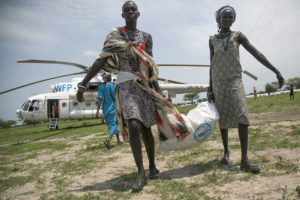Record number of people facing critical lack of food in South Sudan
According to the Integrated Food Security Phase Classification (IPC) update released by the Government of South Sudan in collaboration with the Food and Agriculture Organization of the United Nations (FAO), the United Nations Children’s Fund (UNICEF) and the World Food Programme (WFP), an estimated 6.96 million South…
 According to the Integrated Food Security Phase Classification (IPC) update released by the Government of South Sudan in collaboration with the Food and Agriculture Organization of the United Nations (FAO), the United Nations Children’s Fund (UNICEF) and the World Food Programme (WFP), an estimated 6.96 million South Sudanese will face acute levels of food insecurity or worse (IPC Phases 3, 4 and 5) by the end of July.
According to the Integrated Food Security Phase Classification (IPC) update released by the Government of South Sudan in collaboration with the Food and Agriculture Organization of the United Nations (FAO), the United Nations Children’s Fund (UNICEF) and the World Food Programme (WFP), an estimated 6.96 million South Sudanese will face acute levels of food insecurity or worse (IPC Phases 3, 4 and 5) by the end of July.
An estimated 21,000 people will likely face a catastrophic lack of food access (IPC Phase 5, the highest level in the five-step classification), while about 1.82 million will face Emergency (IPC Phase 4) and another 5.12 million people will face Crisis (IPC Phase 3) levels of food insecurity. Compared to last January’s forecast for the period May – July 2019, 81,000 more people than originally projected are facing IPC Phase 3 or worse, particularly in the Jonglei, Lakes, Unity and Northern Bahr el Gazal states.
Delayed rains, high food prices reduce access to food
The ongoing lean season started early following record low stocks from the poor 2018 harvest and has been further extended by the delayed onset of 2019 seasonal rains. This, combined with persistent economic instability, the effects of previous years of conflict and related asset depletion and population displacements, have contributed to the disruption of livelihoods and has reduced people’s ability to access food. High food prices caused by last year’s poor harvests, market disruptions due to insecurity, high transport costs and a depreciated currency are also contributing to the high levels of acute food insecurity.
The effective implementation of the peace agreement and political stability are imperative to allow urgent and scaled-up humanitarian assistance to protect livelihoods and boost agricultural production across the country to save lives.
“This update to the IPC reveals that much work needs to be done. The recovery of food production and increase of yields in South Sudan are reliant on the maintenance of peace, and must be given a chance,” said Meshack Malo, FAO Representative in South Sudan. “FAO is working with returning farmers to assist them to resettle, build assets and adapt to changing rainfall patterns,” he added. “But there is still much work to be done to increase their ability to deal with such shocks in a sustainable manner.”
“With greater stability in the country, access to those in need has improved, allowing us to treat more than 100,000 children suffering from severe malnutrition in the first five months of the year, with more than 90 per cent of those children recovering,” said Mohamed Ag Ayoya, UNICEF’s Representative in South Sudan. “But malnutrition levels remain critical in many areas and our fear is that the situation could worsen in the coming months.”
“The hunger season coincides with the rainy season and that’s a perfect storm in South Sudan,” said Ronald Sibanda, WFP’s Country Director in South Sudan. “As we ramp up our response, the race is now against time and nature – we must act now to save the lives and livelihoods of the millions on the brink of starvation.”